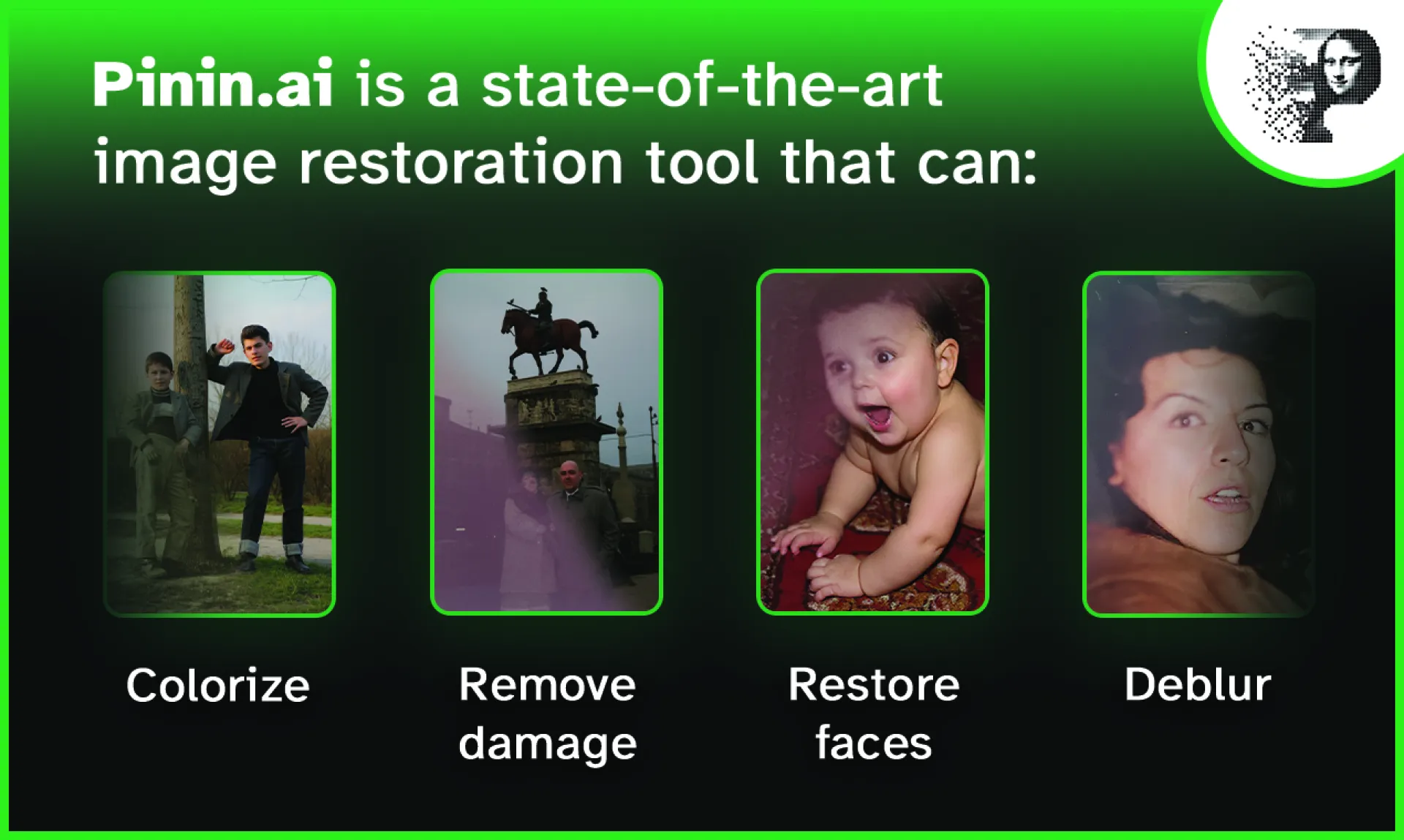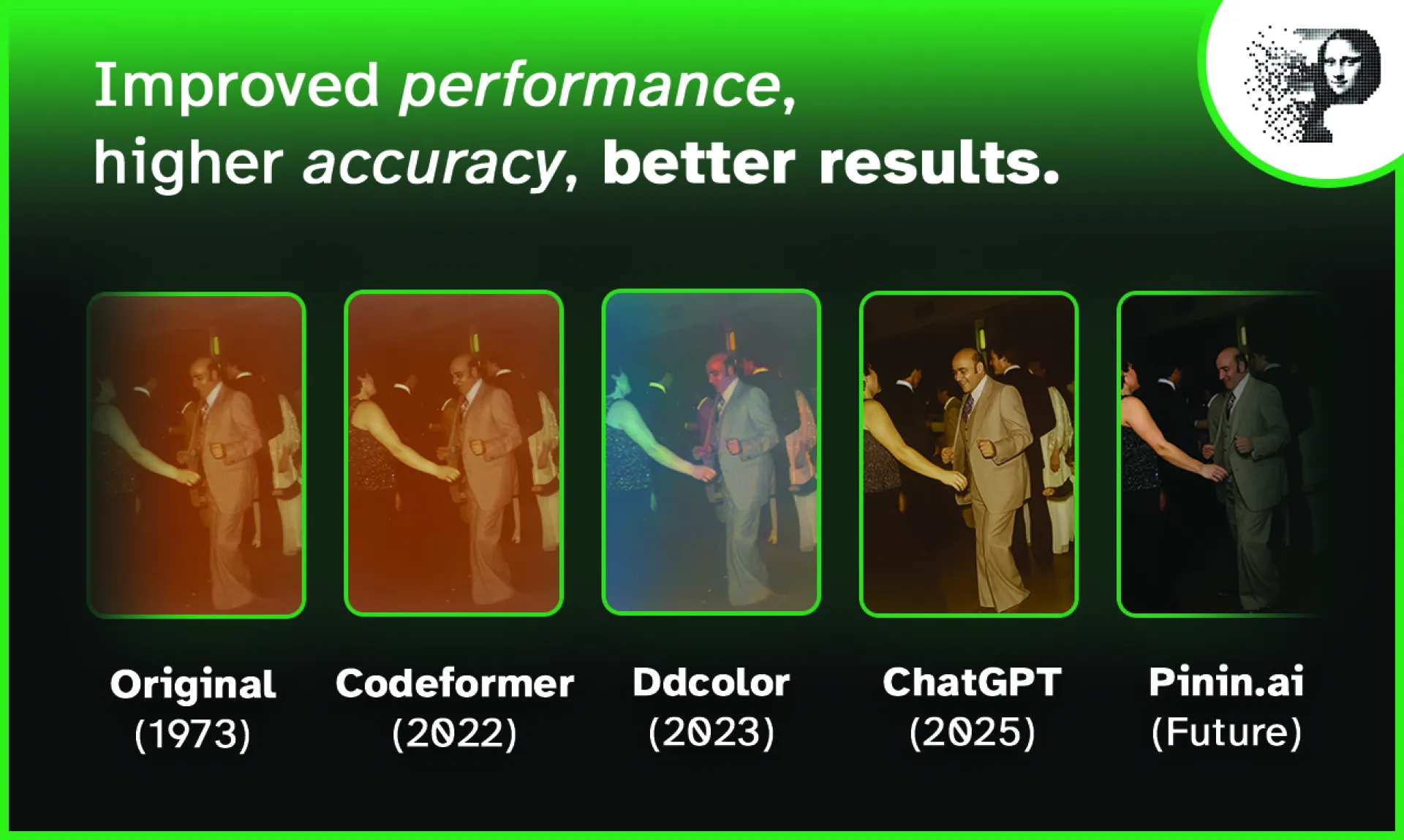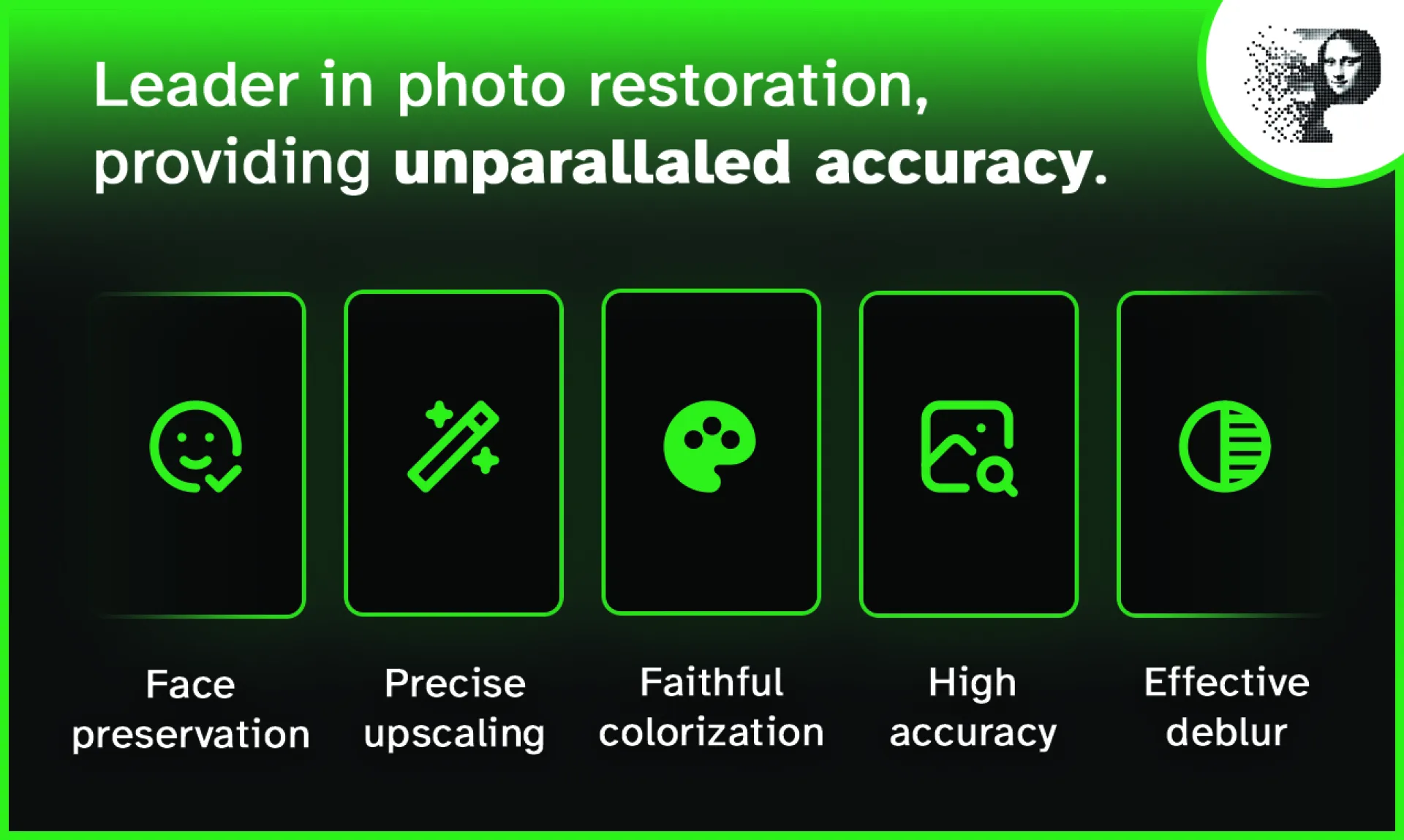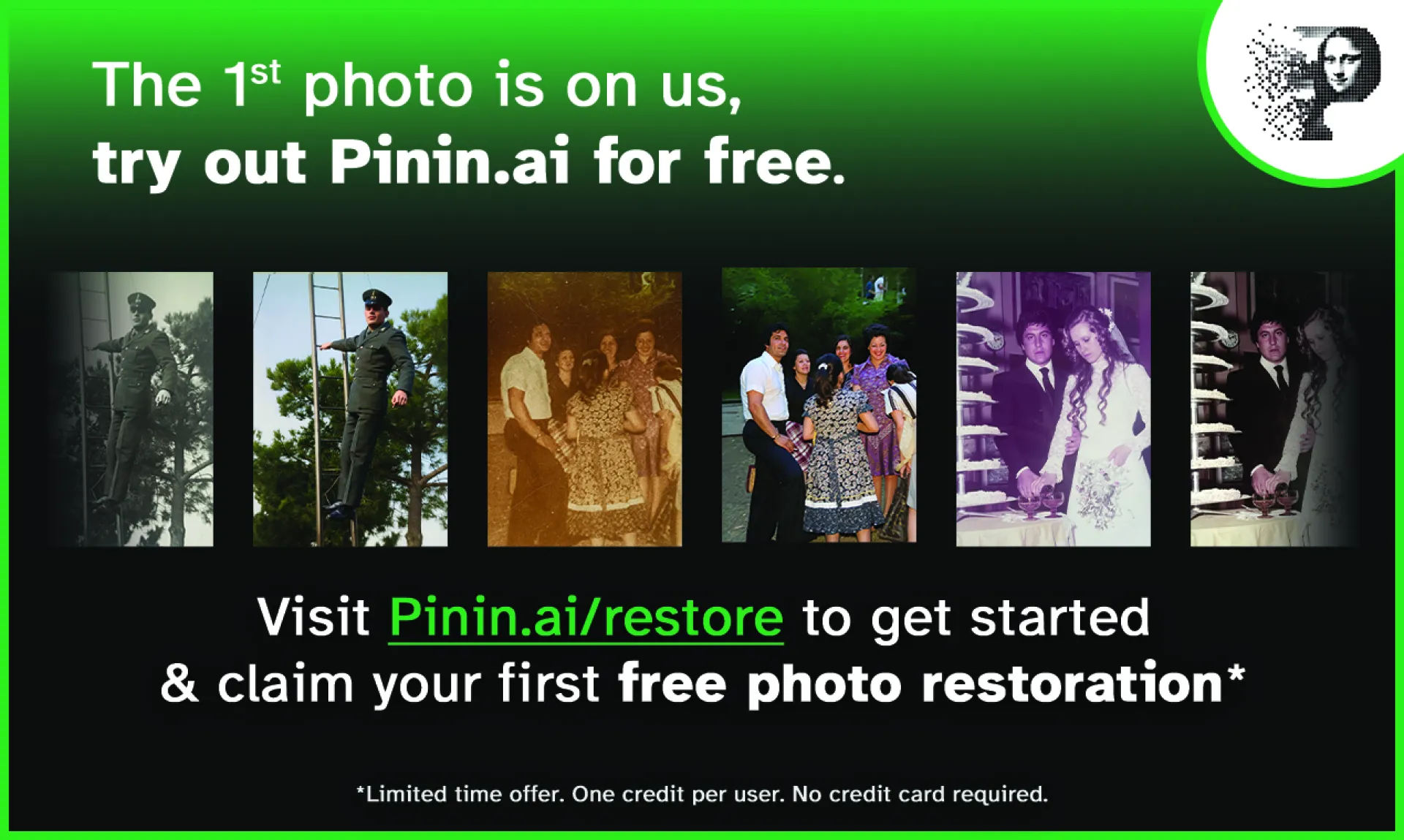This was an incredible ride. Lots of fails, lots of fine-tuning, countless days spent working, but in the end it was all worth it. Before telling you about this story, I'd like to tell you bit about my family and the idea that sparked this project
How it all started
I was born in 🇮🇹 Bari, Italy, and growing up I was lucky enough to experience the "good side" of the modern world, such as photography.
But it wasn't the same for my family. For them, professional photography was often a luxury they couldn't afford. As a result, they were left with hundreds of damaged photos, blurred childhood pictures, wedding pictures that were taken by family members instead of professional photographers - and photo albums full of photos you could barely see.
Decades of memories were barely visible - wedding photos where you couldn't see faces, childhood pictures that looked like watercolor smudges, family gatherings reduced to blurry shadows. However, some of the photos were REALLY good. And all of them were worth saving.
Out of the good family photos, many of them were simply low-resolution and too small for today's screens. Many of these photos were so small, faded and/or damaged that you could barely see the faces. So I decided to build something.
I went through THOUSANDS of family photos - not artificially corrupted images, but real photos with real damage from real families. Water stains, tears, fading, scratches. - and selected 150+ photos that I wanted to restore, bring back to life, and show to my grandmother. I've also asked friends and family members to send me their old photos, and began experimenting.
This is how it all started.
The endless search for the perfect AI photo restoration model
I began digging into existing AI models and tools, then learned about ML, vibe-coding, SaaS, startups and other topics that were unfamiliar to me until an year ago.
Started learning about training datasets. Turns out existing AI models learn from perfect photos - not 1960s Italian family snapshots with coffee stains and tears that were poorly stored inside an old luggage.
Using a model that was trained and fine-tuned on all kinds of photos (ranging from historical images to dusty family portraits from the 90's), I started seeing the first successful photo restorations.
My hopes were up, but little did I know this was just the beginning.
The results were not good enough. The faces were not always being preserved, some details remained lost, AI artifacts often appeared ruining the photos. Occasionally, AI kept turning my uncle's mustache into a shadow and gave my 5-year-old uncle the face of a 40-year-old. 🥸
It sounds funny now, but back then... it wasn't.
So I kept on fine-tuning, testing and fine-tuning. After a month, the results of the photo restorations were similar and comparable to publicly available tools such as ChatGPT*, and better than existing models for photo restoration such as GFPGAN, Ddcolor and Codeformer.
*For those who don't know: you can upload a photo on ChatGPT and ask it to restore the image, preserving details and such. But the result won't ever be the same as the one provided by a model that was specifically trained on restoring photos.
But still, it wasn't good enough. The photo restoration needed to be better. It needed to be something I could proudly show to my family, and perhaps the world. And so it became better. In fact, it became so good that I considered selling it as a service on communities like r/estoration - but then I had a better idea.
Pinin - a dead-simple but extremely advanced AI restoration and enhancement tool that can be used by everyone - even your grandma. Not made for profit - made to allow people to bring their memories, their families and their history back.
Turning the idea into reality
I took a break from all AI models, the endless research and all the fine-tuning when I've joined the Lovable Shipped competition. Amongst the prizes for the competition, there were $100k in cash and a live pitch in front of investors plus a flight to San Francisco. It was an opportunity I couldn't miss.
The competition was the perfect reason to stop waiting for the right moment, and to just do. With my unhealthy perfectionism set aside, I began working on Pinin. The goal was to turn this personal project into something that could actually change other people's lives.
For the following 6 weeks, I've worked non-stop on the branding and the website (both front-end and back-end) all by myself, with no team, no AI specialists and no developers. Every week, I've worked on the assignment on top of the assignments of my roadmap, documented the progress and submitted an update containing all the news, along with all the proofs. Every week for six weeks.
There were all the bells and whistles: legal pages, referral program, GDPR-compliance, magic link auth system for reduced friction and lots of under-the-hood optimizations. I've recorded and edited the final video pitch for investors, submitted it and crossed my fingers. Pinin was ready. I was ready.
The product validation (from my grandmother)
Once the tool was ready, showing it to my family was the biggest satisfaction. We literally took a picture of an old family photo with a phone. Within 20 seconds, it was as if the photo was taken yesterday.
Then, I pulled out the 150+ restored photos that were collected months earlier.
When I showed my grandmother the restored photos, she went silent. Then she started crying. She pointed at her mother in a 50's family portrait and said, "She's beautiful. I forgot she was so beautiful."
This was the moment that made it all worth it. Building something that makes people happy.
📌 Long story short: I didn't win the competition. I didn't even make it to the top 50. I didn't get any prize and I didn't get to pitch the project to investors. But I did finish the website, it was now fully working and presentable. And most importantly, my grandma loved it.
Pinin was born. And it did everything it promised.
This technical challenge turned into something unexpectedly emotional. Turns out family memories hit different when you can actually see them clearly.
It's very important to note that damaged photos aren't just "low quality" images - they're archaeological records. Each type of damage tells a story about where the photo has been and what happened to it. Old cameras had specific optical characteristics - particular types of blur, depth of field patterns, grain structures.
The purpose of Pinin is not to replace old family photos with AI-generated pictures. Pinin brings photos back to life. With all their quirks and all their history - with a better quality, clarity and resolution.
What is Pinin? And what does it do?
Pinin is a state-of-the-art image restoration tool that leverages the latest AI models and technologies to bring photos back to life.
It can colorize, deblur, remove dust & scratches, upscale and much more.
Pinin is not only for old and/or damaged photos. If you or someone in your family have blurry photos, or even photos taken with bad lightning, they can be corrected, restored and improved using Pinin.
Pinin is extremely easy to use. With the magic link login, you only need an email address to try out Pinin. Drag and drop your photos, click the button and watch the magic happen. It’s that simple.
The goal here was to reduce friction, allowing everyone to quickly and accurately restore their photos without paying for manual restoration services that can cost hundreds of dollars.
Free users can upload up to 20 photos at the same time, and paid users can upload up to 100 photos simultaneously while taking advantage of bulk processing, improved quality and processing times.
🔗 Try Pinin.ai’s photo restoration
Why Pinin?
The name 'Pinin' was inspired by Giuseppina “Pinin” Brambilla Barcilon, a famous art restorer known for spending over 20 years restoring the Last Supper of Leonardo Da Vinci.
Pinin.ai aims to carry forward Giuseppina’s values by meticulously analyzing damage and faithfully restoring photos in a way that existing tools can’t.
Although Pinin may not have the same patience (photos are typically processed in 12 seconds on average) or eye for detail that Giuseppina had, it also doesn’t come with the costs normally involved with manual photo restoration.
Nowadays, there are advanced tools and software that allow photo editors to accurately restore photos, but they require a lot of manual work - which usually comes with a bill.
🔗 Learn more about Pinin’s story
Unmatched quality & faithful photo restoration for everyone
The accuracy of Pinin surpasses industry leaders like ChatGPT, and even models that were specifically trained on restoring photos such as Codeformer, ddcolor or GFPGAN.
While other models either do not restore the damage and/or create unwanted artifacts, AI faces and other issues that arise with the use of AI for standard photo generation, Pinin focuses on maintaining the original details and face features.
Most AI models were trained on pristine images, so when they see damage, they hallucinate details instead of intelligently reconstructing them.
With the right prompting, ChatGPT can do wonders. But it’s not ready for image restoration. It was not trained for image restoration. The models used by Pinin were trained on hundreds of photos from all around the world. This allows Pinin to carefully and faithfully restore lost details, faces, words, and even animals.
Does it really work?
In most cases, it really does.
The examples page contains multiple real examples of photos that were restored using Pinin.ai. It showcases the use cases of the tool, that go from restoring damaged photos taken in the 60’s, to de-blurring modern photos, improving the look and resolution of small photos, colorizing, restoring the original colors after fading & much more.
Preserving the original face features and details during the photo restoration process is the hardest part, especially when the details are not visible in the original photos. That’s where Pinin can make mistakes. In some cases, faces may look slightly different than the originals.
And that’s where our refund policy kicks in - Pinin is going to refund your credits if you are not happy with the final result.
So... what's the pricing?
Professional restoration quotes? $30-200 per photo. Imagine that for 200+ damaged photos.
AI models used for image generation, editing and restoration are not free either. They rely on high-performance GPUs to run smoothly and quickly. But using AI is still considerably cheaper than hiring someone that spends hours working on Photoshop, Lightroom and other software to restore photos.
Pinin offers a double pricing model: subscription and pay-per-photo. You can either buy restoration credits for $1USD per credit (1 credit = 1 photo restoration), or get a subscription and save up to 50% on your photo restorations.
Don't need a subscription plan?
No problem. You can purchase photo restoration credits individually for as low as $0.70 per credit. No minimum purchase, and no lock-ins. Safe and instant payments with Stripe.
Even if you decide not to save and buy a subscription, you can still purchase one single credit and restore one photo for less than a coffee.
For those with photos that are particularly difficult to restore and can not be restored by AI, we also offer a manual restoration service starting from only $20 per photo.
Did I already say it's free?
The first photo restoration is completely free. No questions asked. No credit card required. Just head to https://pinin.ai/photo-restoration, login and restore your first photo. 👇
Get your first free photo restoration
TL;DR
I wanted to restore my grandma's old family photos, so I built an AI tool that can accurately restore images and turned it into a product (while still making it accessible to everyone)




Login to post a comment.